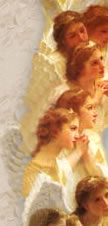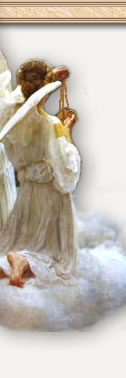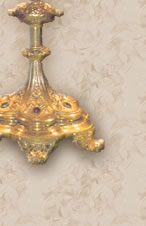




 |
|

|
|
|||||||||||
|
|
|
|
||||||||||||
 |
|
|
||||||||||||
 |
|
 |
|
|||||||||||
|
|
||||||||||||||
 |
 |
|
|
|
|
SPECIAL POSTING
What Does 'Rite' Mean in the Context of Christian Liturgy? Excerpted from The Spirit
of the Liturgy Rites are not rigidly fenced off from each other. There is exchange and crossfertilization between them. The clearest example is in the case of the two great focal points of ritual development: Byzantium and Rome. In their present form, most of the Eastern rites are very strongly marked by Byzantine influences. For its part, Rome has increasingly united the different rites of the West in the universal Roman rite. While Byzantium gave a large part of the Slavic world its special form of divine worship, Rome left its liturgical imprint on the Germanic and Latin peoples and on a part of the Slavs. In the first millennium there -was still liturgical exchange between East and West. Then, of course, the rites hardened into their definitive forms, which allowed hardly any cross-fertilization. What is important is that the great forms of rite embrace many cultures. They not only incorporate the diachronic aspect, but also create communion among different cultures and languages. They elude control by any individual, local community, or regional Church. Unspontaneity is of their essence. In these rites I discover that something is approaching me here that I did not produce myself, that I am entering into something greater than myself, which ultimately derives from divine revelation. That is why the Christian East calls the liturgy the "Divine Liturgy", expressing thereby the liturgy's independence from human control. The West, by contrast, has felt ever more strongly the historical element, which is why Jungmann tried to sum up the Western view in the phrase "the liturgy that has come to be". He wanted to show that this coming-to be still goes on-as an organic growth, not as a specially contrived production. The liturgy can be compared, therefore, not to a piece of technical equipment, something manufactured, but to a plant, something organic that grows and whose laws of growth determine the possibilities of further development. In the West there was, of course, another factor. With his Petrine authority, the pope more and more clearly took over responsibility for liturgical legislation, thus providing a juridical authority for the continuing formation of the liturgy. The more vigorously the primacy was displayed, the more the question came up about the extent and limits of this authority, which, of course, as such had never been considered. After the Second Vatican Council, the impression arose that the pope really could do anything in liturgical matters, especially if he were acting on the mandate of an ecumenical council. Eventually, the idea of the givenness of the liturgy, the fact that one cannot do with it what one will, faded from the public consciousness of the West. In fact, the First Vatican Council had in no way defined the pope as an absolute monarch. On the contrary, it presented him as the guarantor of obedience to the revealed Word. The pope's authority is bound to the Tradition of faith, and that also applies to the liturgy. It is not "manufactured" by the authorities. Even the pope can only be a humble servant of its lawful development and abiding integrity and identity. Here again, as with the questions of icons and sacred music, we come up against the special path trod by the West as opposed to the East. And here again is it true that this special path, which finds space for freedom and historical development, must not be condemned wholesale. However, it would lead to the breaking up of the foundations of Christian identity if the fundamental intuitions of the East, which are the fundamental intuitions of the early Church, were abandoned. The authority of the pope is not unlimited; it is at the service of Sacred Tradition. Still less is any kind of general "freedom" of manufacture, degenerating into spontaneous improvisation, compatible with the essence of faith and liturgy. The greatness of the liturgy depends-we shall have to repeat this frequently-on its unspontaneity (Unbeliebigkeit). Let us ask the question again: "What does 'rite' mean in the context of Christian liturgy?" The answer is: "It is the expression, that has become form, of ecclesiality and of the Church's identity as a historically transcendent communion of liturgical prayer and action." Rite makes concrete the liturgy's bond with that living subject which is the Church, who for her part is characterized by adherence to the form of faith that has developed in the apostolic Tradition. This bond with the subject that is the Church allows for different patterns of liturgy and includes living development, but it equally excludes spontaneous improvisation. This applies to the individual and the community, to the hierarchy and the laity. Because of the historical character of God's action, the "Divine Liturgy" (as they call it in the East) has been fashioned, in a way similar to Scripture, by human beings and their capacities. But it contains an essential exposition of the biblical legacy that goes beyond the limits of the individual rites, and thus it shares in the authority of the Church's faith in its fundamental form. The authority of the liturgy can certainly be compared to that of the great confessions of faith of the early Church. Like these, it developed under the guidance of the Holy Spirit (cf. Jn 16:13). |
|



♦ About The Mass ♦ Resources ♦ How To Help ♦ Contact Us ♦